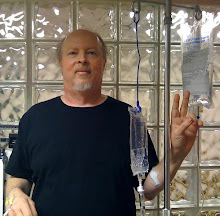skip to main |
skip to sidebar
Yesterday marked the first anniversary of CLL Diary. One year and 57 posts later, I am amazed that I still have anything to say.
When I started this blog I didn’t know how it was going to work out. I figured I would just tell my story as I went along, pretty much stick to the subject of chronic lymphocytic leukemia, and let it go from there.
I am pleased with the response I have gotten. I know the blog has been useful to many of you, both from your comments here and in private e-mails. (It has also occasionally annoyed somebody, but what good would it be if it pleased everybody all the time?) There have been more than 15,000 visits to CLL Diary during the past year, and the number has increased steadily over time.
One effect this blog had was to inspire others to take the plunge into the blogosphere, most notably Dr. Terry Hamblin, whose Mutations of Mortality is a must-read for CLL patients. My friend Steve Madden also started his own blog, then went on to found CLL Forum, so he can be forgiven for putting the blog on the back burner. John Wagner, another friend and fellow patient, maintains an excellent blog, and there are other fine examples that I am pleased to share with you -- see the links on the right side of this page.
One thing I swore 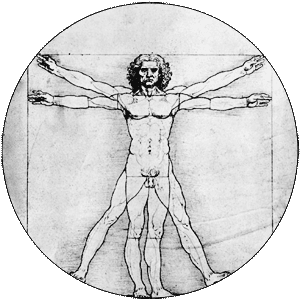 to do when I started blogging was to be honest. This is not always easy. Who wants to admit that their supposition was wrong, their choice mistaken? There is a certain degree of personal exposure that comes with this territory and it is not always comfortable. But if this blog is to be of value, it has to tell the whole story. If this shows me to be someone who absorbs new information and changes his mind, someone who experiences self-doubt, someone who undergoes the downs as well as the ups of life with CLL, then so be it. I have never claimed to have the truth in a bag. I am simply one person struggling with a disease that threatens to take my life.
to do when I started blogging was to be honest. This is not always easy. Who wants to admit that their supposition was wrong, their choice mistaken? There is a certain degree of personal exposure that comes with this territory and it is not always comfortable. But if this blog is to be of value, it has to tell the whole story. If this shows me to be someone who absorbs new information and changes his mind, someone who experiences self-doubt, someone who undergoes the downs as well as the ups of life with CLL, then so be it. I have never claimed to have the truth in a bag. I am simply one person struggling with a disease that threatens to take my life.
Earlier this year I bold-faced my disclaimer, which you can see at the bottom right: “I am not a doctor and I do not play one on the internet.” I think this point needs emphasizing. I am a fellow truth-seeker, someone on the same journey you or a loved one may be on. I have no medical training. I am a guesser. At times I may be an educated guesser, but I am only that.
Dr. John Byrd told me in June that “CLL is a long journey.” It was interesting to hear an expert put it in those terms but his words resonate with me. For most of us it is, indeed, a long journey. When doctors call CLL “the good cancer” they are grading on a curve. Many other cancers bring about ends that are far more abrupt. (I recall my chemo-room neighbor Lynn, who had pancreatic cancer and whom I wrote about this past year.) CBS newsman Ed Bradley lived for 18 years with CLL. I am only guessing here, but I believe I have lived with it for 10. There is no good cancer when it happens to you or someone you love; but the decade or two that most CLLers are granted are lifetimes compared to the spans allotted to many of our compatriots, which can often be measured in months.
When it comes to my CLL journey, the future holds both wonders and monsters a lurking. I have wandered along for three years now using single-agent Rituxan, which is still sort of effective but is, as decorators might say about dated furnishings, a bit tired. During this time HuMax-CD20 has been developed and is nearing the marketplace. Other targeted 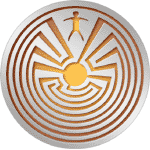 therapies of promise are in the works. We can never know when a stroke of luck, or a stroke of genius, on the part of a researcher somewhere will lead to a new lease on life for us all. More likely, hard work will lead to incremental progress, and I am grateful for anything that will help.
therapies of promise are in the works. We can never know when a stroke of luck, or a stroke of genius, on the part of a researcher somewhere will lead to a new lease on life for us all. More likely, hard work will lead to incremental progress, and I am grateful for anything that will help.
While science progresses, so does the disease. It is reducing my immunoglobulins, perhaps starting to clog up the marrow, turning my once fine immune system into an old clunker that is barely roadworthy. The spectre of more frequent infections lurks, and with it a change in consciousness: I am not immune, and when I pick up a bacterium or a virus I am in danger. This is not something to look forward to, this slow decline. But I am still in the beginning, or at least the early middle, of my journey. Hope is my walking stick, even as I suspect that the climb is unlikely to get easier from here.
Medical matters are only part of this trek. Part of it is emotional, part of it spiritual. I have suffered the initial shock, the fear of dying before what I had always thought of as my time, the joy of remission, the disappointment when a test brings bad news. I can get depressed about all this, and I can live in la-la land and forget about it for awhile (road trips are wonderful for that). But most of all I just put one foot in front of the other and keep plodding away. This is one reason, in addition to my conservative approach to treatment, that I have chosen the tortoise as a metaphor for my approach to CLL.
Another way of coping, another part of the journey, is reaching out to fellow patients and their caregivers. I have always been an empathetic person, probably too sensitive for my own good. As a CLL newbie, I learned how difficult -- how terrifying -- the start of the journey could be. As I made my way, I felt the need to reach out to others who would follow in their own paths, whose earths had also been shattered one day by a phone call, or a doctor leaning forward in his chair and saying, “You have leukemia.”
This blog and my other activities in the CLL community -- I am a moderator at CLL Forum, which now has more than 1,000 members, and I also serve on the board of directors of CLL Topics -- allow me to help as best I can, to share the fellowship that only those of us fighting in this war can know, and to learn from others. Indeed, this blog is the product of a community of knowledge.
And so this blog is a spiritual act, and also a way of coping, of focusing on what to do, of sharing our common experience.
There is a further spiritual dimension that steadies me as I put one foot in front of the other.
In my life  I have walked to the falls in Yosemite and paused below their streaming thunder on a starlit night; I have walked through the damp coastal redwood forests of California, smelling the incense of pine and hearing the call of crows; I have walked across the red earth of Sedona below spires of rock on which petroglyphs have been etched by travelers of centuries past; and I have walked on ancient paths in France, shaded by trees that have stood for centuries and looked down upon passing knights and priests, peasants and kings. My CLL journey is made easier by recognizing, above all else and in spite of everything, the beauty of the spherical cathedral in which we are privileged to live.
I have walked to the falls in Yosemite and paused below their streaming thunder on a starlit night; I have walked through the damp coastal redwood forests of California, smelling the incense of pine and hearing the call of crows; I have walked across the red earth of Sedona below spires of rock on which petroglyphs have been etched by travelers of centuries past; and I have walked on ancient paths in France, shaded by trees that have stood for centuries and looked down upon passing knights and priests, peasants and kings. My CLL journey is made easier by recognizing, above all else and in spite of everything, the beauty of the spherical cathedral in which we are privileged to live.
Every once in awhile a piece of paper crosses your desk that you know is going to have a big impact on your life.
When a fax arrived in 2005 with the results of my IgVH mutational status test, I knew the information it contained was going to tell me if my battle with chronic lymphocytic leukemia would likely be an easy one or a hard one. The news was bad -- unmutated -- which means treatment and retreatment and perhaps, in a last roll of the dice, a stem cell (“bone marrow”) transplant.
Another momentous  fax occurred just recently, while I was undergoing my latest round of Rituxan treatments, on which I will report in the near future. With IV pole in tow, I was returning from the bathroom to my recliner at the infusion room of my hem/onc’s office. There, on the little swing-away table attached to the chair, on which I usually rest crossword puzzles, had appeared another fax, stapled with four pages.
fax occurred just recently, while I was undergoing my latest round of Rituxan treatments, on which I will report in the near future. With IV pole in tow, I was returning from the bathroom to my recliner at the infusion room of my hem/onc’s office. There, on the little swing-away table attached to the chair, on which I usually rest crossword puzzles, had appeared another fax, stapled with four pages.
This one was from the National Marrow Donor Program (NMDP). As readers of this blog may recall, Dr. John Byrd advised me to have my HLA typing done, followed by a preliminary search of the worldwide bone marrow donor database, of which the NMDP is a part. This database is a listing of more than five million volunteer stem cell donors and cord blood units in 43 countries.
Finding donors is really an ethnic matter and I am an ethnic mutt. Half of your HLA tissue types come from your father, half from your mother. My father’s side is Russian Jew and my mother, now deceased, was adopted. I never knew her background for sure, but some digging years ago led me to the conclusion that she was probably Irish, or certainly of British Isles stock. Historically, there has not been a lot of intermingling between lassies from Limerick and Jewish hoteliers from Novosibirsk. And Ashkenazic Jews, while whiter than white, maintained their own communities for centuries and are rather distinct, biologically, from other Caucasians in Europe. All us white folks may look alike, but we’re not.
My prospects are still better than those of any number of ethnic minorities. African-Americans, for example, have less of a chance of finding a match, so much so that the NMDP is trying to encourage more African-Americans to become donors. It currently costs $52 to join the registry and be tissue-typed, but there are discounts for what they call “needed minorities.” What the search is all about
Even before I met with Byrd, I had been gathering that a stem cell transplant could be in my future: If you are younger than about 60 and have progressive CLL, which comes with being unmutated, you may well need a transplant when all the alternatives have been exhausted. Stem cell transplants can give you a new lease on life, literally.
They are risky, of course, and can end in death; but the good news is that in the majority of cases they can provide lengthy remissions and even cures. It is a true roll of the dice, and the odds are improved if you have a matched universal donor, or MUD, someone who  is not a relative and who matches your HLA tissue type in as many ways as possible. (Indeed, even people with the worst CLL prognostics can be cured by such transplants, which are known as allogenic; the success rate is not as good using cells donated from relatives, and even less when one undergoes an autologous, or self transplant, in which you donate your own stem cells.)
is not a relative and who matches your HLA tissue type in as many ways as possible. (Indeed, even people with the worst CLL prognostics can be cured by such transplants, which are known as allogenic; the success rate is not as good using cells donated from relatives, and even less when one undergoes an autologous, or self transplant, in which you donate your own stem cells.)
HLA stands for Human Leukocyte Antigens, which are proteins on the body’s cells. Obviously, if you undergo a transplant and the new cells don’t match the old ones well enough, the body says, “Hey, are you trying to kill me?” and rejects the cells. Thus the need for as good a match as possible. The less perfect the match, the more the odds of success are reduced.
Having your HLA typed and doing the database search is the first step when you need a transplant. But it is also helpful to know the results if you are formulating a long-term treatment strategy, one in which a transplant may become an issue down the road.
Getting some idea of whether there may be a good donor match if and when the time comes can influence your treatment choices. For example, if there is likely to be a match, you may want to save some big chemo guns for your pre-transplant remission, when it is important to get as much clearance of the CLL cells as possible. Campath is one drug, for example, that is used to mop up after therapy, making you as free of CLL as you are likely to get. If it appears there may be no match at all, then you might take a different tack on treatment, perhaps consider using Campath earlier on as part of a program to stall disease progression. All these things vary with the individual, of course, but you get the idea.
Getting it done – cheap!
The good news is that anyone with $165 and a cooperative doctor can learn their basic HLA type and have a preliminary search done.
The place to start is the NMDP’s Office of Patient Advocacy. I cannot say enough good things about these people. They will answer all your questions and send you enough printed material that it might, if stacked end to end, reach the moon. I have spoken to case workers from the office on three occasions, and they have helpful, pleasant, and professional each time.
One of th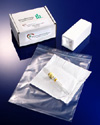 e most useful things they did was recommend Tepnel Labs for my typing test. Since my current health insurance plan does not cover HLA typing (or transplants, for that matter) I am an out-of-pocket player. City of Hope wanted $1600 to do the test. Tepnel will do it for $165. They send a kit to your house, you swab the inside of your cheeks, then return the packet to them by FedEx. After about a month, Tepnel sends you a report listing your HLA typing, which is completely incomprehensible. At your doctor’s request, the NMDP can then run what is known officially as a preliminary search of the donor database, matching your incomprehensible HLA codes against those of others. There is no charge for this. And finally, one day when you are distracted doing something else, a potentially life-changing piece of paper arrives.
e most useful things they did was recommend Tepnel Labs for my typing test. Since my current health insurance plan does not cover HLA typing (or transplants, for that matter) I am an out-of-pocket player. City of Hope wanted $1600 to do the test. Tepnel will do it for $165. They send a kit to your house, you swab the inside of your cheeks, then return the packet to them by FedEx. After about a month, Tepnel sends you a report listing your HLA typing, which is completely incomprehensible. At your doctor’s request, the NMDP can then run what is known officially as a preliminary search of the donor database, matching your incomprehensible HLA codes against those of others. There is no charge for this. And finally, one day when you are distracted doing something else, a potentially life-changing piece of paper arrives.
It should be emphasized here that the preliminary search is just that, preliminary. It is done by what is known as low resolution typing and on what are regarded as the six most important markers (A, B, and DR, and we each inherit a double set of these). If you go ahead with the transplant search -- this is known as a formal search -- the pool of potential donors will be narrowed. Your transplant team will request a test on higher resolution, which could reduce the field, and they may look for a stronger match -- a 6/6 might work, but a 10/10 is even better. And matching isn't everything; matters such as infectious disease histories can come into play. For example, if you are negative for the cytomegalovirus and your potential donor is positive, it may not be a good idea to use that donor’s cells. This next step in the search process can co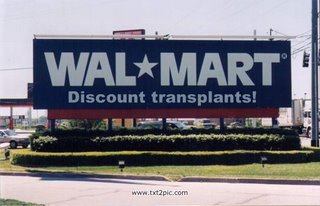 st $30,000 or more, and the transplant itself can run between $300,000 and $400,000. (At this point, yours truly will be working as the world’s most churlish Wal-Mart greeter, if that’s what it takes to get insured for a transplant.)
st $30,000 or more, and the transplant itself can run between $300,000 and $400,000. (At this point, yours truly will be working as the world’s most churlish Wal-Mart greeter, if that’s what it takes to get insured for a transplant.)
My results
As I shuffled back to my chair, I knew what awaited me, since my doctor and I had been talking about it recently and we expected the results any day. I sat down and settled in, careful not to kink the IV line, and picked up the fax.
Out of five million adult stem cell donors in 43 countries, a total of 17 were potential matches on 6 of 6 points. On 5 of 6, the total was an additional 668.
This was  good news. The sea is not swimming with donors for me, but I do have a pondful; there are enough potentially perfect matches that I might find a decent one when the time comes. People drop out of the database -- reasons include pregnancy, flying anvils, reaching the age of 60, which is when a donor’s cells are not considered to be useful any longer. And new people join. But I can reasonably assume that, if and when the time comes, there will be between 10 and 20 potential 6/6 matches for me -- perhaps more, as the number of donors has only grown over the years.
good news. The sea is not swimming with donors for me, but I do have a pondful; there are enough potentially perfect matches that I might find a decent one when the time comes. People drop out of the database -- reasons include pregnancy, flying anvils, reaching the age of 60, which is when a donor’s cells are not considered to be useful any longer. And new people join. But I can reasonably assume that, if and when the time comes, there will be between 10 and 20 potential 6/6 matches for me -- perhaps more, as the number of donors has only grown over the years.
There are those who come back with hundreds of matches, and those who come back with zero. In a subsequent conversation with a NMDP patient advocate, she described my results as “hopeful.” However, the pool is still small and it is possible that no 10/10 donors will be found. A cord blood transplant remains another option, and the NMDP will report those matches to you as well. I had no 6/6 but hundreds of 5/6, and in cord blood transplants you can get by with a 4/6 if the cords are large.
At least I now know that a transplant is a realistic option for me. You cannot roll the dice without having dice to roll.
RESOURCES
The National Cancer Institute has a presentation that walks you through the basics of stem cell transplants, complete with plenty of big cartoon pictures to illustrate the main points.
UPDATE
If you know your HLA typing, the National Marrow Donor Program now allows you to run a preliminary search for 6/6 matches in its registry. I just ran mine and found that I am up to 22 potential 6/6 matches, an increase of five in about a year. For more information, go to this page.
-- September 21, 2007
I pretty much stick to CLL in this blog. I try to avoid politics because it is divisive, and because I think we CLL patients need to put our common cause first and all else second. (If you want to see a great example of this, go to CLL Forum, where conservatives and liberals coexist in good-natured friendship.) But it is in the spirit of our common cause that I am now venturing into, ahem, politics.
On Tuesday, November 7, American voters will go the polls to choose 435 members of the House, a third of the Senate, and any number of governorships. In Arizona, we are also voting on 19 ballot propositions. In Sedona, we are even electing the board that oversees our fire department. There’s a whole lot of votin' to do!
The purpose of this post is to urge you to vote Democratic. Not because Democrats are perfect and Republicans are evil. Not because of the mess in Iraq and George Bush’s insanity, which is defined as doing the same thing over and over and expecting different results. Not even because it is time that we had some checks and balances in our government, which our founders intended, as opposed to one-party rule.
I am urging you to vote Democratic because, as the slogan goes, the ass yo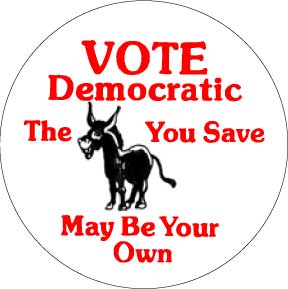 u save may be your own. Ask yourself: Which party is more likely to fund medical research? Which party is more likely to insure access to health insurance?
u save may be your own. Ask yourself: Which party is more likely to fund medical research? Which party is more likely to insure access to health insurance?
If you answered “Republican,” BONK!
Did you know that George Bush has proposed a cut of $40 million in funds for the National Cancer Institute in 2007? And that the NCI funds the CLL Research Consortium? The Consortium's 4-year grant from the NCI has expired. My understanding is that this funding has not been renewed. And while the Consortium isn’t going away, it’s not getting much help from the government anymore, nor will it with Bush and the GOP calling the shots.
In April, acting NCI chief Dr. John Niederhuber gave a talk at MIT. “The NCI’s stagnant budget," it was reported, "which was about $4.8 billion in fiscal 2005 and fiscal 2006, doesn't keep up with inflation, so the funding actually amounts to a deficit, Niederhuber admitted.”
In October, from another report on Bush’s $40 million cut: “That funding cut, argued Martin D. Abeloff, director of the Sidney Kimmel Comprehensive Cancer Center at Johns Hopkins Hospital in Baltimore, will have a devastating effect on the progress of research of new cancer drug therapies.
“In an era when death rates for breast, colon, and lung cancers are declining and new targeted therapies for rare cancers [such as CLL] are on the 'cusp' of development, he said, 'this couldn't be a worse time' for a decrease in NCI funding.
“Many 'world-class scientists,' Abeloff maintained, already spend much of their time on writing grant proposals rather than on essential research activities.
“And their 'reward,' he lamented, is that less than 10% of those grant proposals get funded.”
Now, which party is more likely to restore that $40 million? Which party is more likely to increase funding for cancer research? Yes, the party that has traditionally taken an interest in health care and social programs. Vote Democratic and restore the $40 million; vote Republican and make Bill Gates’ multi-million-dollar tax cut permanent.
Let’s look at another issue: access to health insurance. Some 50 million Americans are without it. What have the Republicans done about this since Bush took office? Nothing. What will they do? Nothing. And if you're having trouble paying skyrocketing premiums? Nothing.
The Democrats are not going to turn our health care system into a government-run nightmare (as opposed to the privately-run one that we have today). Bill Clinton learned the hard way that powerful interests will block any attempt to establish a national single-payer system. But Democrats will make reforms, they will try to address the imbalances, and if they have the votes they will eventually insure that all Americans have access to insurance coverage.
the votes they will eventually insure that all Americans have access to insurance coverage.
Pre-existing condition such as CLL preventing you from getting care? The GOP doesn’t care. A longstanding Democratic proposal has been to let people in their 50s buy into Medicare. In 2004 John Kerry wanted to let people buy into the same federal program that senators and congresspeople get. If Mark Foley comes down with CLL, he’s covered, even now that he has quit his job. What about you?
I’m not talking about people wanting free health care. I am talking about people who can pay being denied coverage for pre-existing conditions.
This is personal. I am self-employed and my insurer won’t cover stem cell transplants. What do you think my chances are of finding an insurer or a program that will?Better under the Democrats.
RESOURCES
Advocacy page at the Leukemia and Lymphoma Society website.
 to do when I started blogging was to be honest. This is not always easy. Who wants to admit that their supposition was wrong, their choice mistaken? There is a certain degree of personal exposure that comes with this territory and it is not always comfortable. But if this blog is to be of value, it has to tell the whole story. If this shows me to be someone who absorbs new information and changes his mind, someone who experiences self-doubt, someone who undergoes the downs as well as the ups of life with CLL, then so be it. I have never claimed to have the truth in a bag. I am simply one person struggling with a disease that threatens to take my life.
to do when I started blogging was to be honest. This is not always easy. Who wants to admit that their supposition was wrong, their choice mistaken? There is a certain degree of personal exposure that comes with this territory and it is not always comfortable. But if this blog is to be of value, it has to tell the whole story. If this shows me to be someone who absorbs new information and changes his mind, someone who experiences self-doubt, someone who undergoes the downs as well as the ups of life with CLL, then so be it. I have never claimed to have the truth in a bag. I am simply one person struggling with a disease that threatens to take my life. therapies of promise are in the works. We can never know when a stroke of luck, or a stroke of genius, on the part of a researcher somewhere will lead to a new lease on life for us all. More likely, hard work will lead to incremental progress, and I am grateful for anything that will help.
therapies of promise are in the works. We can never know when a stroke of luck, or a stroke of genius, on the part of a researcher somewhere will lead to a new lease on life for us all. More likely, hard work will lead to incremental progress, and I am grateful for anything that will help. I have walked to the falls in Yosemite and paused below their streaming thunder on a starlit night; I have walked through the damp coastal redwood forests of California, smelling the incense of pine and hearing the call of crows; I have walked across the red earth of Sedona below spires of rock on which petroglyphs have been etched by travelers of centuries past; and I have walked on ancient paths in France, shaded by trees that have stood for centuries and looked down upon passing knights and priests, peasants and kings.
I have walked to the falls in Yosemite and paused below their streaming thunder on a starlit night; I have walked through the damp coastal redwood forests of California, smelling the incense of pine and hearing the call of crows; I have walked across the red earth of Sedona below spires of rock on which petroglyphs have been etched by travelers of centuries past; and I have walked on ancient paths in France, shaded by trees that have stood for centuries and looked down upon passing knights and priests, peasants and kings. 







